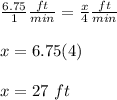Part 1) 9 and 1 over 2 divided by 1 over 4
Part 2) 18, because the number of catalogs is 72 over 5 divided by 4 over 5
Part 3) 3.2
Part 4) 3.6 with bar over 6
Part 5) 4 over 7 and 4 over 9
Part 6) 43 over 9
Part 7) Benny spent to go to the summer camp $280.00
Part 8) $124
Part 9) (−$11) ⋅ 12
Part 10) -27 ft
Step-by-step explanation:
Part 1)
Let
x ------> the number of days
we now that
The total distance jogged must be equal to the distance jogged each day multiplied by the number of days

Solve for x

therefore
The number of days is
9 and 1 over 2 divided by 1 over 4
Part 2)
Let
x ----> the number of catalogs
we know that
To find out the number of catalogs, divide the wide of the shelf by the thick of each catalog

therefore
18, because the number of catalogs is 72 over 5 divided by 4 over 5
Part 3) Convert 16 over 5 to a decimal
we know that

Part 4) How can 33 over 9 be expressed as a decimal?
we know that
 ----> is a repeating decimal
----> is a repeating decimal
therefore
3.6 with bar over 6
Part 5) Which of the following numbers can be expressed as repeating decimals?
Verify each case
case a) 4 over 7
 ----> is a repeating decimal
----> is a repeating decimal
case b) 2 over 5
 ----> is a terminating decimal
----> is a terminating decimal
case c) 7 over 8
 ----> is a terminating decimal
----> is a terminating decimal
case d) 4 over 9
 ----> is a repeating decimal
----> is a repeating decimal
therefore
4 over 7 and 4 over 9
Part 6) Which of the following rational numbers is equal to 4 point 7 with bar over 7 ?
Verify each case
case a) 43 over 9

case b) 49 over 9

case c) 35 over 9

case d) 32 over 9

therefore
43 over 9
Part 7)
we know that
1)Benny deposited $92.50 into his account every month for 10 month
so

2) He used $36.50 every month to pay for art lessons
 -----> total money left in his account after 10 months
-----> total money left in his account after 10 months
3) After 10 months, he used 1 over 2 of the total money left in his account to go to a summer camp for artists
so

therefore
Benny spent to go to the summer camp $280.00
Part 8)
we know that
1) Mini earned $160 during the summer doing chores
2) She bought 3 dresses worth $12 each using her chore money.
so

To find out how much money was left, subtract $36 from the amount earned during the summer doing chores

therefore
$124
Part 9)
we have
1 year=12 months
Let
x ----> the total deductions for the year
we know that
The total deductions for the year is equal to the Ryan's tennis club membership multiplied by the number of a months in a year
so

therefore
(−$11) ⋅ 12
Part 10)
we know that
The total depth of a submarine is 45 ft

15% of 45 ft is
(0.15)(45)=6.75 ft
using proportion
Find out the deep after 4 minutes
Let
x ----> the deep after 4 minutes

therefore
-27 ft